Published on August 5th, 2021
By Marc Frenkiel
The Miami metro has always been a fascinating place from a real estate development and acquisitions standpoint. It was not long ago when it seemed like the area had been overdeveloped to the point of reaching a permanent housing glut. But it seems like the tide has shifted as a result of the COVID-19 pandemic, and a comparison of two headlines — pre and post pandemic — proves this.
A June 2019 Wall Street Journal article told us that “In Miami, There Are Too Many Condos and Not Enough Foreign Buyers,” while in June 2021, The Real Deal published an article called “Selling out: South Florida condo developers report feverish market.” Housing demand is surging in the Miami metro, so much so that as of May 2021, roughly 40,000 units are under construction, which will increase the metro’s housing stock by nearly 13%.
While south Florida is no stranger to boom and bust cycles, one thing is clear right now: Even a freezing day in Miami won’t turn the metro’s hot multifamily market cold. Here’s what’s changed and what you need to know to stay ahead.
What you need to know to keep up
Widespread work-from-home protocols gave workers the ability to work from anywhere, and many chose to decamp to south Florida, known for it’s tropical climate and 0% state income taxes. Businesses took note as well, with many Northeastern businesses deciding to relocate or open satellite offices in the Miami metro.
The mayor of Miami proper, Francis Suarez, is actively courting the technology industry to relocate to the metro that he hopes to transform into “Silicon Beach.” Already on its way to becoming the cryptocurrency capital of the world, mayor Suarez is focusing on “differentiating our economy by creating the new wave of technological products that will incentivize people to move to Miami and be part of our tech ecosystem.”
Is it any wonder that the Miami metro has experienced some of the fastest real estate recovery amongst all gateway markets?
According to Apartment List’s July 2021 Rent Report, the 10 largest submarkets of the Miami metro have experienced double digit percent rent increases on a year over year basis. Miami Beach — the most expensive city in the metro — has seen rents increase 14.9% over the past year while rents in Fort Lauderdale — the metro’s most inexpensive city — have grown by 11.4%. It’s worth noting that Fort Lauderdale has an estimated population of around 183,000 compared to Miami Beach’s 90,000. Does this correlate with the country’s newfound aversion to crowded cities, or is that trend reversing? Let us know your thoughts in the comment box below.
What you need to know to stay ahead
With surging demand comes a heightened need to work quickly and efficiently in order to provide the best possible experience for incoming leads.
Seek award-winning AI to automate repetitive tasks
One way to better handle elevated prospect activity is by capitalizing on the latest advancements in artificial intelligence built for leasing. This technology can respond to inquiries instantly, at any hour of the day (or night), leaving your (human) leasing staff with more bandwidth to focus on higher level interactions. Data shows that the faster a property manager or leasing assistant can reply to a prospective renter’s initial inquiry, the greater the chances of obtaining a signed lease. According to Zillow, a response in the first 1-2 minutes of receiving the inquiry leads to a 40% chance of prospect engagement. Waiting even 30 minutes to respond plummets that likelihood to 10%. Providing an instant follow-up response increases the chances of prospect engagement, and in turn, a higher likelihood of conversion.
Cater to prospective renters from near and far
As Florida’s population spurt comes from inbound migration, tools that optimize virtual showings and allow prospective renters to tour a unit from outside the state have never been more important. Interestingly, it turns out that many renters actually like having the option to do virtual showings. In a 2020 study, 40% of renters said that post-pandemic, they would like to have the option to view units both virtually and in-person, while 13% said they prefer to view units virtually. 80% of renters who signed a new lease during the pandemic and participated in a virtual showing said they were satisfied with it.
Approach your software selection with a growth mindset
With increased construction activity in the Miami metro area comes an opportunity to grow your property management business, and therefore, your teams.
In a 2019 survey of over 500 property managers, 30.4% identified the need to train employees as a major factor inhibiting growth, as “time spent training eats into time spent growing the business.” The leading property management products have embedded training tools, such as how-to videos, self-guided courses, and a user-community. When paired with intuitive software design, these staffing and training tools get new hires up to speed faster, streamlining the onboarding experience and flattening the learning curve.
We surveyed our most satisfied AppFolio customers and 83% were able to train employees on our software in less than one month. 68% reported that onboarding new employees was faster with AppFolio than with other solutions they have used.*
Use smart home technology to lower utility bills and promote sustainability
Whether or not current inflation is merely transitory (as the Federal Reserve asserts), here and now, many are noticing price increases on key items. Coupled with rent increases in the Miami metropolitan area, consumers are seeking relief. So why not give your residents a way to lower their utility bills? According to Numbeo.com, the average utility bill for a 915 square foot apartment in Miami comes in at $142.35, and the U.S Energy Information Administration reports that half of a household’s annual energy consumption is for heating and air conditioning.
In hot and humid south Florida, air conditioning will always be a necessity. As a result of rising temperatures, the city of Miami has appointed the world’s first Chief Heat Officer to raise awareness and implement plans to combat the physical and economic toll of extreme heat.
But property owners too can play a role in promoting more sustainable energy consumption — while providing indirect financial relief to residents. How? With the help of smart home technology.
Smart home technology refers to home / community amenities and appliances that connect to the Internet, enabling communication, automation, and remote control for the end-user. Examples include thermostats that can be turned up or down remotely, parking sensors that provide occupancy data and violation alerts in real-time, and door locks that enable remote-controlled building and unit access. One company leading the way in the development of smart home technology is SmartRent. Among the many benefits of AppFolio Property Manager Plus’s integration with SmartRent is the ability for residents to control their air conditioning systems remotely. After all, why keep the A/C running in an empty home? Instead, give your residents the option to turn off their HVAC system when they step out and power it up — from anywhere — once their homebound ETA is known. Check out our latest episode of the Top Floor podcast for a deeper dive into our upcoming smart home integrations as well as the benefits of having a smart home system that works with your property management platform
Adapt to increased scrutiny
As a result of the tragic events in Surfside comes intense scrutiny on property maintenance and inspections. And rightfully so.
In order to adapt to changing regulations and better maintain your (or your clients’) assets, it can be helpful to establish more concrete workflows for technicians to follow, guiding them through the maintenance / inspection process while placing emphasis on certain areas. AppFolio’s Workflow Management feature allows property managers to build multi-step processes according to unique specifications directly into their software.Once an individual task is complete, the next is seamlessly handed off to the next team member by assigning next steps with a custom note for clearer communication and expectations. With this approach, work is completed efficiently and correctly the first time around.
For greater peace of mind across the board, streamlined, reliable, and well-documented communications are more important than ever. Maintenance requests of all kinds should be addressed right away, and modern property management software offers solutions to track your residents’ requests and provide timely follow up. Make sure to select a system that supports all mobile devices and allows for photos to be uploaded directly from a smartphone. Additionally, it’s important that maintenance technicians be able to use their property management software in areas with spotty-to-no internet or cell service, such as an underground parking garage.
Looking forward
While Miami metro real estate is no stranger to boom and bust cycles, the current boom feels different. With many employees now flexible to work from anywhere, the lifestyle and economic draws of the Sunshine State have never been stronger. Will it last? Only time will tell.
*Source: April 2021 TechValidate survey of 500+ satisfied AppFolio customers









Comments by Marc Frenkiel